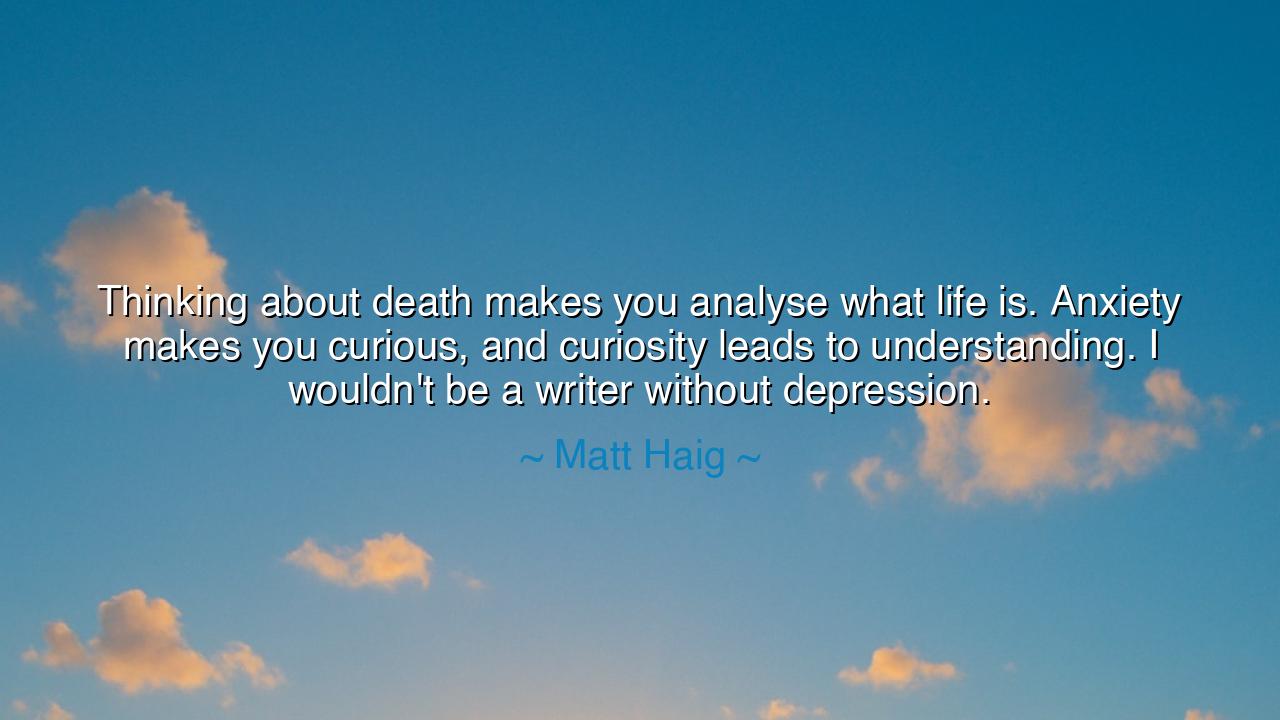
Thinking about death makes you analyse what life is. Anxiety
Thinking about death makes you analyse what life is. Anxiety makes you curious, and curiosity leads to understanding. I wouldn't be a writer without depression.






The author Matt Haig once said, “Thinking about death makes you analyse what life is. Anxiety makes you curious, and curiosity leads to understanding. I wouldn’t be a writer without depression.”
In these words lies the quiet fire of wisdom born from suffering. They speak not from the comfort of ease, but from the furnace of despair — from one who has walked through the shadow and returned bearing light. Haig, who has written deeply about mental illness and the meaning of existence, reveals that even pain, when faced with courage, becomes a teacher. For what is death but the mirror in which life is seen most clearly? What is anxiety but the restless hunger of the mind to understand its place in an uncertain world? And what is depression but the night through which the soul must travel to rediscover the dawn?
In the ancient world, this truth was already known to the philosophers and poets. Socrates, on the eve of his execution, told his disciples that to think of death is not to despair, but to awaken — for only those who confront mortality can truly appreciate the miracle of being. The Stoics, too, taught memento mori, “remember you must die,” not as a call to sadness, but to clarity. By contemplating the end, one learns to live with purpose. Haig’s reflection continues this lineage of wisdom: in facing the terror of death, we strip away the trivial and cling to what is real — love, creation, and understanding.
Anxiety, he says, makes one curious — and in that statement lies profound insight. The anxious mind is often restless because it feels the fragility of life, the chaos of existence. But within that turmoil hides an energy, a searching spirit. The same intensity that fuels fear can fuel discovery. The same mind that trembles before the unknown can, if guided rightly, seek to understand it. This is how suffering becomes transformation: the wound becomes the doorway, the trembling hand becomes the hand that writes. The poet Rainer Maria Rilke once said, “Let everything happen to you: beauty and terror. Just keep going. No feeling is final.” Haig echoes this ancient courage — the understanding that even the darkest storms carry light within them.
The third part of his wisdom is the most personal, and the most universal: “I wouldn’t be a writer without depression.” For in his pain, Haig discovered not an enemy, but a depth of empathy and perception that became his art. Many great creators of history have walked the same path. Vincent van Gogh, haunted by torment, painted fields of blazing color as though his spirit wrestled with the heavens. Abraham Lincoln, burdened by melancholy, found in his suffering the strength of compassion and patience that guided a nation through war. From the abyss, they brought forth beauty and wisdom. Haig reminds us that depression, though cruel, can be the forge where sensitivity and truth are shaped.
There is no romance in pain — and Haig never pretends there is — but there is meaning in how one faces it. To transform suffering into understanding is an act of profound alchemy. The ancient mystics called this “the dark night of the soul,” a sacred passage where the self is stripped of illusion and remade anew. Those who endure such nights emerge with clearer eyes, for they have seen both the depths of despair and the fragile glory of life. In this way, Haig’s words are both confession and invitation: to see suffering not only as curse, but as a potential source of wisdom, if we have the courage to face it.
The lesson, then, is this: pain is not the end of meaning; it is the beginning of awareness. When death whispers, listen — it teaches you how to live. When anxiety stirs, observe — it shows you what you truly care about. When depression descends, endure — it may be the soil from which your compassion and creativity grow. The ancients taught that the greatest strength lies not in avoiding hardship, but in transforming it. Just as the seed must break to sprout, so too must the human heart crack open to understand the fullness of existence.
So, my child of the restless mind, remember this teaching: do not flee from your darkness, but learn from it. When fear and sorrow visit you, greet them not as enemies, but as stern teachers who will one day depart, leaving wisdom in their wake. Write, create, love, or simply endure — but never let pain be without purpose. For as Matt Haig shows, when one dares to look into the face of death, one learns to cherish life. When one walks through anxiety, one learns curiosity. And when one survives depression, one discovers the power to turn suffering into understanding — and understanding into light.






AAdministratorAdministrator
Welcome, honored guests. Please leave a comment, we will respond soon